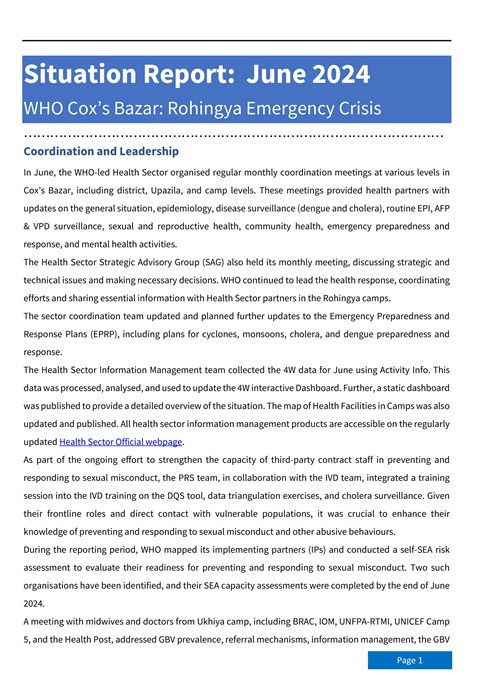WHO Cox’s Bazar: Rohingya emergency crisis - Situation Report: June 2024
Situation report

Overview
Coordination and Leadership
In June, the WHO-led Health Sector organised regular monthly coordination meetings at various levels in Cox’s Bazar, including district, Upazila, and camp levels. These meetings provided health partners with updates on the general situation, epidemiology, disease surveillance (dengue and cholera), routine EPI, AFP & VPD surveillance, sexual and reproductive health, community health, emergency preparedness and response, and mental health activities.
The Health Sector Strategic Advisory Group (SAG) also held its monthly meeting, discussing strategic and technical issues and making necessary decisions. WHO continued to lead the health response, coordinating efforts and sharing essential information with Health Sector partners in the Rohingya camps.
The sector coordination team updated and planned further updates to the Emergency Preparedness and Response Plans (EPRP), including plans for cyclones, monsoons, cholera, and dengue preparedness and response.
The Health Sector Information Management team collected the 4W data for June using Activity Info. This data was processed, analysed, and used to update the 4W interactive Dashboard. Further, a static dashboard was published to provide a detailed overview of the situation. The map of Health Facilities in Camps was also updated and published. All health sector information management products are accessible on the regularly updated Health Sector Official webpage.
As part of the ongoing effort to strengthen the capacity of third-party contract staff in preventing and responding to sexual misconduct, the PRS team, in collaboration with the IVD team, integrated a training session into the IVD training on the DQS tool, data triangulation exercises, and cholera surveillance. Given their frontline roles and direct contact with vulnerable populations, it was crucial to enhance their knowledge of preventing and responding to sexual misconduct and other abusive behaviours.
During the reporting period, WHO mapped its implementing partners (IPs) and conducted a self-SEA risk assessment to evaluate their readiness for preventing and responding to sexual misconduct. Two such organisations have been identified, and their SEA capacity assessments were completed by the end of June 2024.1)
